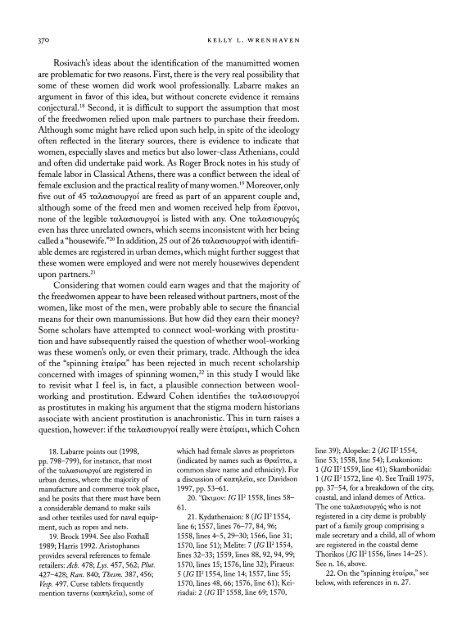Download - The American School of Classical Studies at Athens
Download - The American School of Classical Studies at Athens
Download - The American School of Classical Studies at Athens
You also want an ePaper? Increase the reach of your titles
YUMPU automatically turns print PDFs into web optimized ePapers that Google loves.
370<br />
KELLY L. WRENHAVEN<br />
Rosivach's ideas about the identific<strong>at</strong>ion <strong>of</strong> the manumitted women<br />
are problem<strong>at</strong>ic for two reasons. First, there is the very real possibility th<strong>at</strong><br />
some <strong>of</strong> these women did work wool pr<strong>of</strong>essionally. Labarre makes an<br />
argument in favor <strong>of</strong> this idea, but without concrete evidence it remains<br />
conjectural.18 Second, it is difficult to support the assumption<br />
th<strong>at</strong> most<br />
<strong>of</strong> the freedwomen relied upon male partners<br />
to<br />
purchase<br />
their freedom.<br />
Although<br />
some<br />
might<br />
have relied upon such<br />
help,<br />
in<br />
spite <strong>of</strong> the<br />
ideology<br />
<strong>of</strong>ten reflected in the<br />
literary sources, there is evidence to indic<strong>at</strong>e th<strong>at</strong><br />
women, especially slaves and metics but also lower-class Athenians, could<br />
and <strong>of</strong>ten did undertake paid work. As Roger Brock notes in his study <strong>of</strong><br />
female labor in <strong>Classical</strong> <strong>Athens</strong>, there was a conflict between the ideal <strong>of</strong><br />
female exclusion and the practical reality <strong>of</strong> many women.19 Moreover, only<br />
five out <strong>of</strong> 45 x<strong>at</strong>axoionpyoi are freed as part <strong>of</strong> an apparent couple and,<br />
although some <strong>of</strong> the freed men and women received help from epocvoi,<br />
none <strong>of</strong> the legible xocA-ocouropyoi<br />
is listed with any. One x<strong>at</strong>axoioupyoq<br />
even has three unrel<strong>at</strong>ed owners, which seems inconsistent with her being<br />
called a "housewife."20 In addition, 25 out <strong>of</strong> 26 xaA,aoio\)pyoi with identifi<br />
able demes are registered in urban demes, which might further suggest th<strong>at</strong><br />
these women were employed and were not merely housewives dependent<br />
upon partners.21<br />
Considering<br />
th<strong>at</strong> women could earn<br />
wages and th<strong>at</strong> the<br />
majority<br />
<strong>of</strong><br />
the freedwomen appear<br />
to have been released without partners,<br />
most <strong>of</strong> the<br />
women, like most <strong>of</strong> the men, were probably<br />
able to secure the financial<br />
means for their own manumissions. But how did earn<br />
they<br />
their<br />
money?<br />
Some scholars have <strong>at</strong>tempted to connect wool-working with prostitu<br />
tion and have<br />
subsequently<br />
raised the<br />
question<br />
<strong>of</strong> whether wool-working<br />
was these women's or even<br />
only,<br />
their<br />
primary,<br />
trade. Although<br />
the idea<br />
<strong>of</strong> the<br />
"spinning excupa" has been rejected in much recent scholarship<br />
concerned with images<br />
<strong>of</strong><br />
spinning women,22 in this study<br />
I would like<br />
to revisit wh<strong>at</strong> I feel is, in fact, a plausible<br />
connection between wool<br />
working and prostitution. Edward Cohen identifies the xaA,aaun)pyoi<br />
as<br />
prostitutes<br />
in<br />
making<br />
his argument th<strong>at</strong> the<br />
stigma<br />
modern historians<br />
associ<strong>at</strong>e with ancient prostitution is anachronistic. This in turn raises a<br />
question, however: if the xaAxxcioupyoi really were exocipoci, which Cohen<br />
18. Labarre<br />
points out (1998,<br />
pp. 798-799), for instance, th<strong>at</strong> most<br />
<strong>of</strong> the T<strong>at</strong>axGioDpyoi<br />
are<br />
registered<br />
in<br />
urban demes, where the<br />
majority<br />
<strong>of</strong><br />
manufacture and commerce took place,<br />
and he posits th<strong>at</strong> there must have been<br />
a considerable demand to make sails<br />
and other textiles used for naval equip<br />
ment, such as ropes and nets.<br />
19. Brock 1994. See also Foxhall<br />
1989; Harris 1992. Aristophanes<br />
several references to female<br />
provides<br />
retailers: Ach. 478; Lys. 457, 562; Plut.<br />
427-428; Ran. 840; <strong>The</strong>sm. 387, 456;<br />
Vesp. 497. Curse tablets frequently<br />
mention taverns (K0C7rn^?Ta), some <strong>of</strong><br />
which had female slaves as<br />
proprietors<br />
(indic<strong>at</strong>ed by names such as 0pama,<br />
a<br />
common slave name and<br />
ethnicity).<br />
For<br />
a discussion <strong>of</strong> Ka7rnXei(x, see Davidson<br />
1997, pp. 53-61.<br />
20. "Qkuiov: /GIF 1558, lines 58<br />
61.<br />
21. Kyd<strong>at</strong>henaion:<br />
8 (/GIF 1554,<br />
line 6; 1557, lines 76-77, 84, 96;<br />
1558, lines 4-5,29-30; 1566, line 31;<br />
1570, line 51); Melite: 7 (IG IF 1554,<br />
lines 32-33; 1559, lines 88, 92, 94, 99;<br />
1570, lines 15; 1576, line 32); Piraeus:<br />
5 (IG IF 1554, line 14; 1557, line 55;<br />
1570, lines 48, 66; 1576, line 61); Kei<br />
riadai: 2 (IG IF 1558, line 69; 1570,<br />
line 39); Alopeke: 2 (IG IF 1554,<br />
line 53; 1558, line 54); Leukonion:<br />
1 (IG IP 1559, line 41); Skambonidai:<br />
1 (IG IP 1572, line 4). See Traill 1975,<br />
pp. 37-54, for a breakdown <strong>of</strong> the city,<br />
coastal, and inland demes <strong>of</strong> Attica.<br />
<strong>The</strong> one<br />
xaXaaioDpyoc; who is not<br />
registered<br />
in a city deme is probably<br />
part <strong>of</strong> a family group comprising a<br />
male secretary and a child, all <strong>of</strong> whom<br />
are<br />
registered<br />
in the coastal deme<br />
Thorikos (IG IP 1556, lines 14-25).<br />
See n. 16, above.<br />
22. On the<br />
"spinning exaipa,"<br />
below, with references in n. 27.<br />
see
















